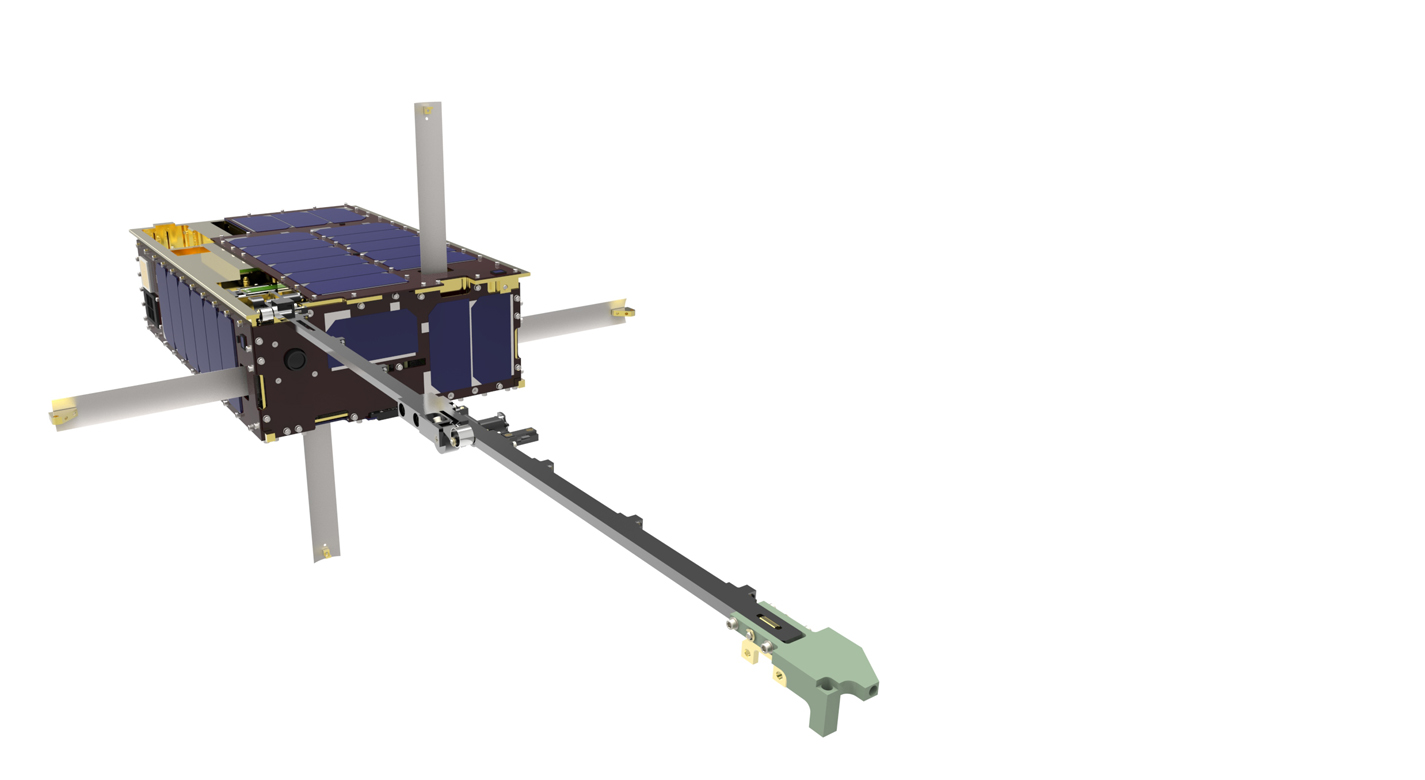Dellingr 6U CubeSat
aerospace
Dellingr 6U CubeSat (GSC-TOPS-37)
An innovative, reliable CubeSat design for executing small science-grade missions inexpensively and rapidly
Overview
CubeSats, once the domain of university researchers, have become increasingly more popular in recent years among government researchers. Motivated in large by their growing capabilities and relatively inexpensive cost, NASA and other government agencies are increasing their investments in CubeSats. NASA now is funding CubeSat mission opportunities through various programs.
In addition to their low cost, CubeSats enable mission configurations not possible with more traditional approaches. Instead of launching just one satellite, mission planners could deploy swarms or constellations of these tiny platforms to execute simultaneous, multi-point observations.
Technologists, meanwhile, also are interested in using CubeSats. Before mission planners can infuse a prototype technology, its developers must first demonstrate the technology in a relevant end-to-end space environment. CubeSats have the potential to offer the needed access at greatly reduced costs.
The Technology
A NASA team gave itself just one year to develop, test and integrate a CubeSat that could reliably and easily accommodate agency-class science investigations and technology demonstrations at a lower cost. The CubeSat known as Dellingr, a name derived from the god of the dawn in Norse mythology will carry three heliophysics-related payloads. It doubles the payload capability of the ubiquitous and proven three-unit, or 3U, CubeSat pioneered by the California Polytechnic Institute in 1999 primarily for the university community.
The need for such a platform, which measures about 12 inches long, nearly 8 inches wide and 4 inches high, was for more cost-effective approaches to achieve compelling Earth and space science.
Disadvantages of the 3U size include more constraints on volume and power. Furthermore, some studies suggest that previous CubeSats failed 40 percent of the time. By doubling the platform's girth, increasing its power capacity, and employing novel processes to increase its on-orbit reliability, the team believes it will have created a platform capable of carrying out more robust missions for science.
Once successfully demonstrated, the team says it will make the platform's design implemented with low-cost, commercial off-the-shelf parts available to any U.S. organization interested in using it.


Benefits
- More reliable than previous CubeSat designs
- Cost effective design
- More robust in terms of volume and power than previous CubeSat designs
Applications
- Dellingr can serve as a replacement to any 3U CubeSat in academia, government, and industry.
|
Tags:
|
Similar Results

SmallSat Standardized Architecture
SmallSat Standardized Architecture is architecture that is modularized, pressurizable, thermally controlled spacecraft-designed to host ruggedized commercial off-the-shelf (COTS) instrumentation in a terrestrial-like environment on orbit. The architecture takes advantage of a pressurizable volume for both spacecraft and payload systems. The pressurizable volume provides multiple benefits, primarily in thermal design. By maintaining one atmosphere of pressure inside the SmallSat, materials that might otherwise outgas and/or fail and/or cause significant contamination issues, are no longer a concern. This also means that certain vibration-absorbing materials/designs used in COTS hardware can be used on orbit. Additionally, printed circuit boards do not have to be redesigned for thermal requirements, plus conformal coating and contamination bake-outs are no longer required.
The SmallSat architecture is designed to take advantage of the United States Air Force (USAF) Rideshare Program and the Evolved Expendable Launch Vehicle Secondary Payload Adaptor (ESPA) ring. The ESPA ring comes in two sizes: standard and Grande. The architecture has two main configurations, one designed for the ESPA Grande, and the other for the standard ESPA ring. The ESPA Grande version is a hockey-puck-shaped spacecraft bus measuring approximately 40 inches in diameter and 20 inches in height. This version takes full advantage of the ESPA Grandes 300-kilogram capability per attachment point.

Miniaturized Astrometric Alignment Sensor
The Miniaturized Astrometric Alignment Sensor advances satellite capabilities for astrophysical measurements, necessary for formation flying, relative navigation, and virtual telescope capabilities. The sensor is a single assembly consisting of a small, low powered camera assembly. The sensor detects stellar objects from which both stellar and object tracking are performed. The sensors components consist of a low power camera assembly, interchangeable lenses, camera power supply, and image processing software and algorithms. The system functions by searching and identifying objects in the camera's field of view and tracking the objects against a selected star pattern with a central body of interest in the sensor's field of view.
The Miniaturized Astrometric Alignment Sensor makes it possible to measure a spacecrafts altitude and orientation with respect to known stellar objects. The instrument takes an image of a patch of sky, identifies the stars in that field of view, and compares the field view with a stored star map. The data is processed with a dedicated processor attached to the instrument to spell out the attitude and orientation of a spacecraft.

CubeSat Compatible High Resolution Thermal Infrared Imager
This dual band infrared imaging system is capable of spatial resolution of 60 m from orbit and earth observing expected NEDT less than 0.2o C. It is designed to fit within the top two-thirds of a 3U CubeSat envelope, installed on the International Space Station, or deployed on other orbiting or airborne platforms. This infrared imaging system will utilize a newly conceived strained-layer superlattice GaSb/InAs broadband detector array cooled to 60 K by a miniature mechanical cryocooler. The camera is controlled by a sensor chip assembly consisting of a newly developed 25 m pitch, 640 x 512 pixel.

Diminutive Assembly for Nanosatellite deploYables (DANY)
SmallSat designers seek to employ restraints and release mechanisms of minimal size and weight, often placing each on the outside of the SmallSat structure. Surprisingly, "fishing line" (released via burn through) is often used to secure and release deployables. Vibrations and forces generated during launch can stretch the fishing line, thus allowing these precious deployables to become damaged or otherwise not release properly later on. While these small sats are less expensive than their larger counterparts, satellite owners must minimize the chance that deployables are damaged or that deployment is unsuccessful.
Five years ago, engineers at NASA GSFC faced these SmallSat deployment challenges and knew a better way must exist to prevent equipment damage and ensure successful release. Investigating a host of designs to minimize size, weight, and cost while maximizing communication and mechanical reliability, NASA's engineers created DANY (the Diminutive Assembly for Nanosatellite deploYables). NASA's DANY technology uses spring-loaded metal pins, a reliable burn-through mechanism, efficient bracketing, and a circuit board - all within a 3.0" x 1.3" x 0.2" volume (smaller than a stack of 10 business cards) - to reliably stow and release deployables on command. Using DANY, stowed deployables are securely fastened using the spring-loaded locking pins. Upon receiving a deployment signal, a plastic restraining link is burned through which allows the spring-loaded pins to release the deployable and simultaneously trigger a switch to signal a successful deployment event.

Nanosatellite Launch Adapter System
NLAS consists of three configurable subsystems to meet the needs of a multi-spacecraft launch. The Adapter is the primary structure that provides volume for secondary payloads between the rocket and the primary spacecraft. The Adapter takes advantage of the frequently unused volume within the rocket fairing. It fits up to 4 NLAS Dispenser units, or 8 eight Poly-PicoSatellite Orbital Deployers (P-PODs), or any combination thereof. The NLAS Dispenser is reconfigurable to support either two 3U bays or a single 6U bay and is compatible with 1U, 1.5U, 2U, 3U, and 6U satellites. The Dispenser system is the first 6U deployment system backwards compatible to 3U spacecraft. Finally, the NLAS deployment Sequencer is an internally powered subsystem which accepts an initiation signal from the launch vehicle and manages the actuations for each deployment device per a user programmable time sequence. It is programmed using ground support equipment (GSE) and a simple graphical user interface (GUI) on a computer.



